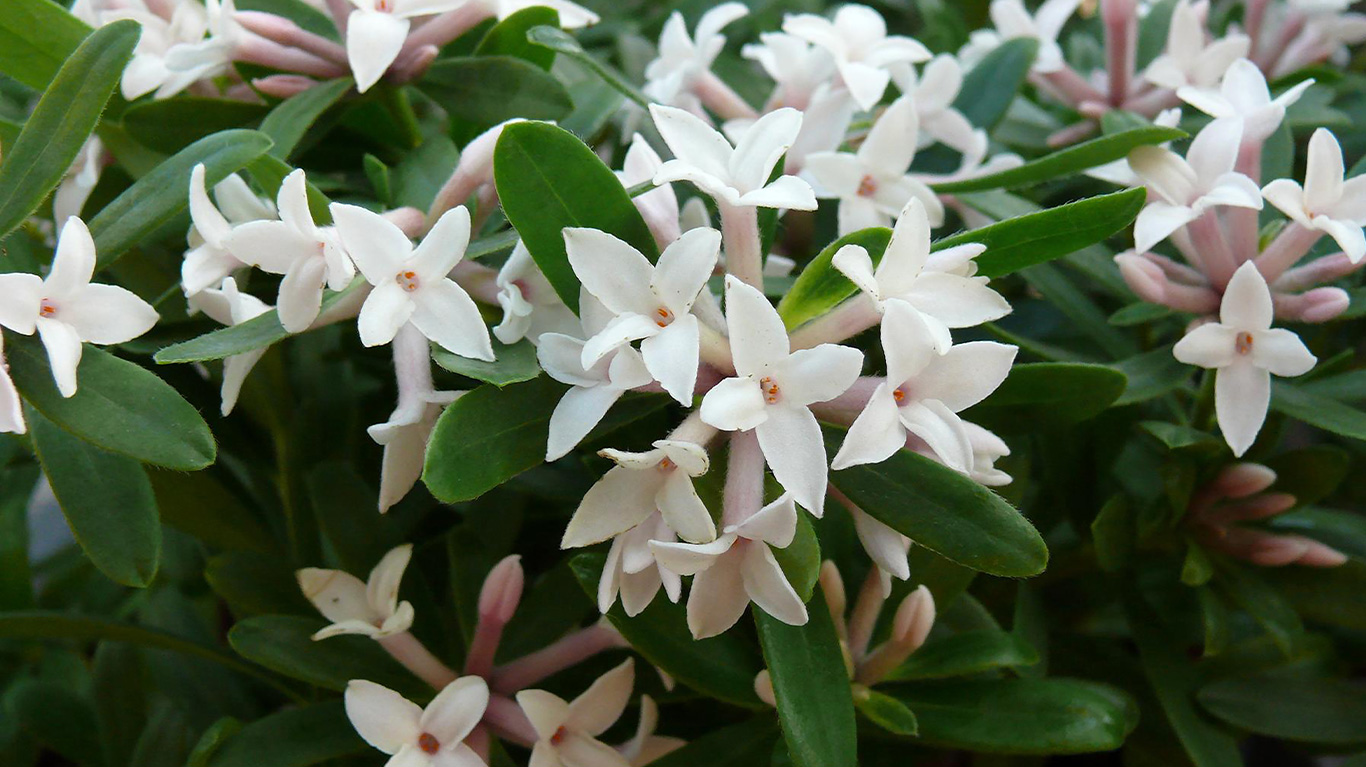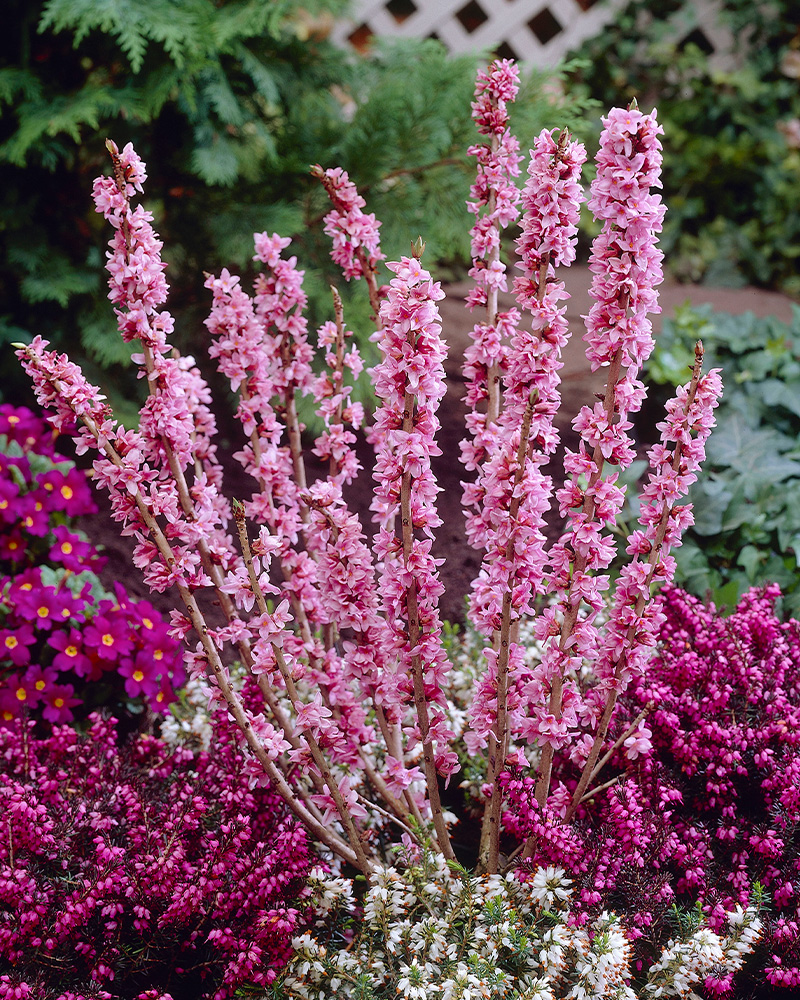
What We've Included
Introduction | How to Plant | Where to Plant | How to Prune | How to Propagate | Inspiration
The best Daphne for Year-round Colour and Scent
Since most daphne's are slow-growing, they are an obvious choice for short-of -space-gardeners and there are many enticing varieties to choose from. With attractive polished green foliage and generous clusters of white perfumed flowers flushed pink, the scented blooms are followed by black berries that are foraged by birds. They are super easy to grow in well-drained soil and prefer light shade so are excellent for North-facing spaces. The good news is that one or two varieties will thrive in full shade too.
How to Plant Daphne's
As their origins suggest, daphne's are beautiful plants that can be grown in many different locations and are loved by gardeners the world over for their heady perfume, stunning flowers and smart mid-green, glossy foliage. Tolerant of all soil types, Daphne's provide welcome colour, structure and perfume to the garden.
Our daphne plants are supplied in pots and root balls. Here’s how to grow yours!
- Dig a hole in the border that’s big enough to house the entire module. If planting in pots, fill a large pot halfway with potting soil and then make several holes that can hold the modules. Do this until the top of the soil from the module is just below the top of the pot.
- Fill around the modules with soil and firm down gently.
- Water well and you’re done.

Where to Plant Daphne Shrubs
Being woodland plants daphne shrubs prefer a shady location in the garden and love a warm, sheltered corner. If you’re tight for space, they can also be grown in containers although they tend to do better in the ground because they dislike disturbance.
However, as long as you plant them in a decent-sized pot and aren’t planning on replanting them for a few years they will grow quite happily if kept fed and watered. If you’re unsure, choose one of the alpine varieties that will thrive in pots and rockeries. Once established, daphne's flower reliably, they need little or no maintenance other than rich fertile soil, regular watering and minimal pruning.
How to Prune Daphne Shrubs
Daphne shrubs are easy to prune and because they are slow growers you may well find they need no pruning at all during the first three years. Give them a light trim in spring after flowering or summer by removing any damaged stems or any that spoil the overall shape of this stunning shrub.
How to Propagate Daphne’s
Daphne’s can be propagated by seed, but it takes years to get a worthwhile plant so semi-ripe cuttings or layering are the fastest methods of generating new plants. Using either of these methods guarantees you’ll get a new shrub identical in every way to the mother plant and of course, both layering and cuttings are free. Follow these simple steps to propagate Daphne's in your garden.
Taking Daphne semi-ripe cuttings
Daphne semi-ripe cuttings are taken from August to September and it’s best to take cuttings early in the morning when both the leaves and stems are full of water.
1. Have a plastic bag ready lined with a damp paper towel to collect your cuttings until you’re ready to pot them up. Cuttings are best taken in the morning when the stems and leaves are still full of water.
2. You can take as many cuttings as you like and store them in the bag until you’re ready to use them. If you aren’t planting your cuttings immediately, store them in the refrigerator for 24 hours but it’s best to use them as soon as possible.
3. Choose your cutting material from healthy, non-flowering side stems, and cut just above a leaf node.
4. Fill a tray with a mix of cutting compost and perlite, then firm the surface.
5. Water the tray before inserting the cuttings so as not to disturb the new stems once they are planted. Allow excess water to drain away before planting the cuttings.
6. Using scissors, prepare the cutting by removing the lower leaves, leaving two sets of leaves at the top. Insert the cutting into the compost and lightly firm it in place.
7. Put them in a propagator and keep the compost moist, not wet, so the cuttings don’t dry out or rot and place the propagator in a light place out of bright sunlight.
8. Cuttings should root in 4-6 weeks when you can pot them up in individual 9 cm pots and grow them on.
Layering Daphne shrubs
Many shrubs naturally produce low-hanging or trailing stems that touch the
soil and you can use these lax stems to make identical new daphne plants for free. Layering is easy and even beginners should see great results.
1. Choose a stem that is lying on the soil, nick the stem lightly to encourage it to root and pin it firmly down with a wooden or metal peg.
2. Secure the peg with a stone or brick to keep the stem firmly in contact with the soil.
3. After several weeks roots should form at the point at which the stem was touching the ground.
4. Once roots have developed the new plant can be cut loose from the mother plant with a clean sharp knife and planted in a well-drained 9cm pot or small container.
5. Keep the soil moist and after a few weeks the new plant should have developed enough of a root system to be planted in the open ground.
Ready to Shop?
Find some inspiration for your garden
